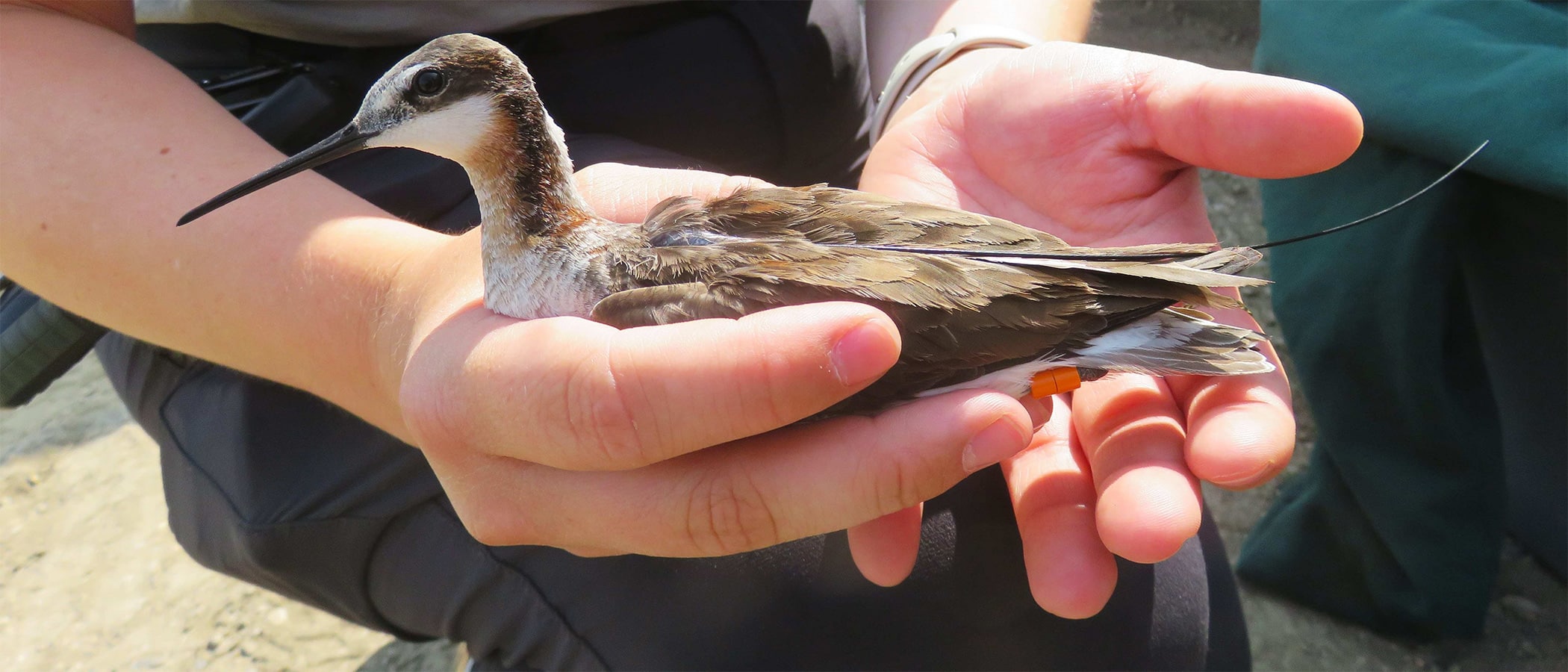
Editor’s note: This article was compiled from field reports from Ryan Carle and Kiki Tarr.
Phalarope research continued at Mono Lake again this summer, with phalarope surveys taking place for the fifth consecutive year, plus a new effort to tag phalaropes so they can be tracked by Motus towers throughout the Americas (see box below). Ryan Carle and Kiki Tarr of Oikonos Ecosystem Knowledge coordinated the surveys and the tagging effort.
Phalarope surveys
Twelve phalarope surveys total took place July through September, specifically timed to coincide with surveys at five other major phalarope migratory stops in western North America. “Coordinated surveys help researchers track large-scale patterns in phalarope habitat, population, and movement,” Kiki explained. Surveys happened by boat and on shore at the same time to thoroughly cover Mono Lake’s vast phalarope habitat.
This year, the surveys recorded relatively few Wilson’s Phalaropes at Mono Lake, with a peak number of approximately 6,000 in early July. At the same time, Owens Lake, which normally hosts only a few thousand Wilson’s Phalaropes, had record numbers of approximately 27,000 birds. Owens had substantial water in it due to the record snowpack and runoff, temporarily providing better bird habitat than usual. Ryan said, “When habitat reappears, the phalaropes will use it!”
Red-necked Phalaropes arrived in record numbers at Mono Lake this season. Oikonos recorded 32,618 of them on a late-August survey, which far surpassed the previous published single-day Mono Lake record of 21,000 birds. Other North American survey sites also reported large numbers of Red-necked Phalaropes this year.
Phalarope tagging
This summer, after years of planning, researchers successfully tagged 25 Wilson’s Phalaropes in Canada and California, but unfortunately efforts at Mono Lake were unsuccessful.
During several frustrating weeks the Oikonos team and Dr. Margaret Rubega from the University of Connecticut tried to capture and tag Wilson’s Phalaropes at Mono Lake. The capture method that had worked for Dr. Rubega in the 1990s was to wait until the birds had gained enough weight from eating shrimp and flies that they couldn’t quickly take off from the water, making them easy to scoop up with a net. This year the team’s timing was off and the phalaropes remained agile, flying away when boats approached. Next year, altering the timing and possibly the method of capture should result in some tagged phalaropes at Mono Lake.
Signals from phalaropes that were tagged this summer have so far been picked up by Motus towers at Great Salt Lake, the Salton Sea, in Baja California, and in Jalisco, Mexico. The birds are making their way toward South America for the winter!
Motus comes to Mono Lake
by Robbie Di Paolo
The Mono Lake Committee constructed and activated the first Motus system at Mono Lake on July 1, 2023. Motus is an automated radio-tracking antenna system that detects and records radio-tagged organisms that pass within nine miles of it. The system currently consists of a single array with plans to add three more at different locations near Mono Lake.
Our goal is to detect tagged phalaropes on the lake to aid and enhance ongoing phalarope research. The system will also support science by detecting any organism tagged with Motus-capable tags, which are actively deployed on birds, bats, butterflies, and all kinds of animals throughout the Americas and worldwide for a variety of research projects. The current Motus array will detect any tagged organism that passes by its field of view, confirming the organism’s presence at Mono Lake. As additional arrays are set up in the coming years, researchers will be able to infer distributions and movement of tagged organisms throughout the lake.
This post was also published as an article in the Fall 2023 Mono Lake Newsletter. Top photo courtesy of Ryan Carle.
